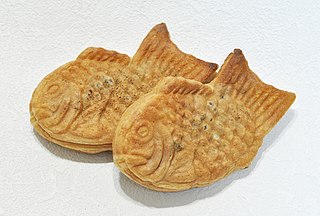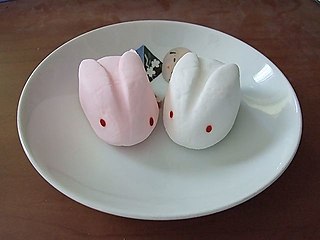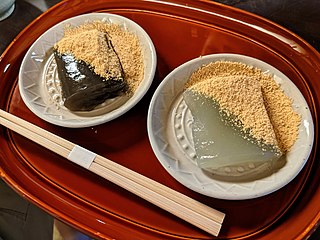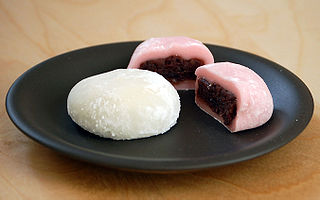
Confectionery is the art of making confections, or sweet foods. Confections are items that are rich in sugar and carbohydrates although exact definitions are difficult. In general, however, confections are divided into two broad and somewhat overlapping categories: bakers' confections and sugar confections.

Mochi is a Japanese rice cake made of mochigome (もち米), a short-grain japonica glutinous rice, and sometimes other ingredients such as water, sugar, and cornstarch. The steamed rice is pounded into paste and molded into the desired shape. In Japan, it is traditionally made in a ceremony called mochitsuki. While eaten year-round, mochi is a traditional food for the Japanese New Year, and is commonly sold and eaten during that time.

Uirō, also known as uirō-mochi (外郎餅), is a traditional Japanese steamed cake made of glutinous rice flour and sugar. It is chewy, similar to mochi, and subtly sweet. Flavors include azuki bean paste, green tea (matcha), yuzu, strawberry and chestnut. Nagoya is particularly famous for its uirō, and there are other regional versions, notably in Yamaguchi and Odawara, although Odawara's uirō is better known as a medicine. It can be purchased in traditional Japanese confectionery shops throughout Japan.

Taiyaki is a Japanese fish-shaped cake, commonly sold as street food. It imitates the shape of tai, which it is named after. The most common filling is red bean paste that is made from sweetened adzuki beans. Other common fillings may be custard, chocolate, cheese, or sweet potato. Some shops even sell taiyaki with okonomiyaki, gyoza filling, or a sausage inside. Smaller, differently shaped versions called kingyoyaki are also available and often sold in bags of five, ten, or more.

Wagashi is a traditional Japanese confection that is often served with green tea, especially the type made of mochi, anko, and fruit. Wagashi is typically made from plant-based ingredients with an emphasis on seasonality, and generally making use of cooking methods that pre-date Western influence in Japan.

Monaka (最中) is a Japanese sweet made of azuki bean paste sandwiched between two thin crisp wafers made from mochi. The wafers can have the shape of a square, a triangle, or may be shaped like cherry blossoms, chrysanthemums, local landmarks, daruma, or other good luck symbols.

Mitsuwa Marketplace is a Japanese supermarket chain in America, with locations in California, Illinois, Texas, Hawaii, and New Jersey.

Mochi ice cream is a confection made from Japanese mochi with an ice cream filling. It was invented by Japanese-American businesswoman and community activist Frances Hashimoto with help from her husband, Joel.

Miyagegashi refers to a sweet made with the purpose of selling it as a souvenir. As with most other Japanese souvenirs, the typical miyagegashi is a regional specialty and cannot be bought outside its specific geographic area. The making and selling of omiyagegashi is an important part of Japan's souvenir industry.

Sakuramochi is a Japanese confection (wagashi) consisting of sweet, pink-colored rice cake (mochi) with red bean paste (anko) filling, wrapped in a pickled cherry blossom (sakura) leaf, which may or may not be eaten depending on individual preference.

Warabimochi is a wagashi made from warabiko and covered or dipped in kinako. Kuromitsu syrup is sometimes poured on top before serving as an added sweetener.

Frances Kazuko Hashimoto was an American businesswoman, schoolteacher, and social activist. She was a key figure and proponent of Los Angeles' Little Tokyo neighborhood. She was the head of Mikawaya confectionery company since 1970, where Hashimoto, the inventor of mochi ice cream, also introduced the dessert to American consumers.

Tokyo Banana is a Japanese banana-shaped sponge cake with cream filling. It is the official souvenir sweet of Tokyo and is manufactured and sold by Grapestone Co..

Daifukumochi (大福餅), or daifuku (大福), is a wagashi, a type of Japanese confection, consisting of a small round mochi stuffed with a sweet filling, most commonly anko, a sweetened red bean paste made from azuki beans. Daifuku is a popular wagashi in Japan and is often served with green tea.

Nijiya Market is a Japanese supermarket chain headquartered in Torrance, California, with store locations in California and Hawaii. The store's rainbow logo is intended to represent a bridge between Japan and the United States.

Ichimonjiya Wasuke is a traditional confectionery company located in Kita-ku, Kyoto, Japan. It was established in the year 1000 and is operated by the 25th generation of the same family. The recent building is about 300 years old and contains many benches and stools around small tables. Local people call the shop "Ichiwa".















